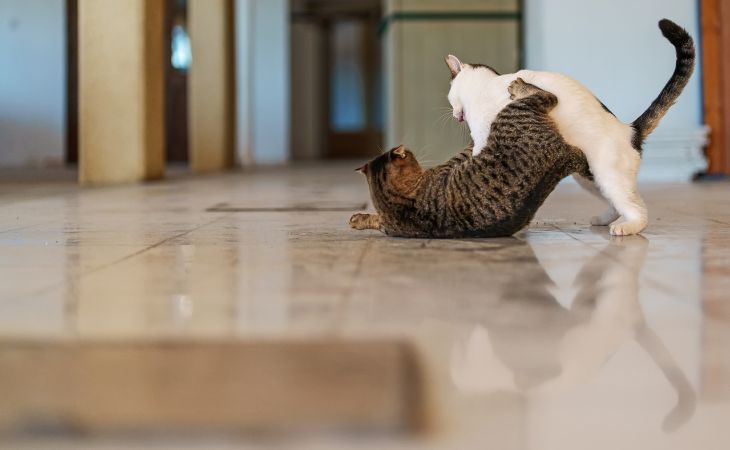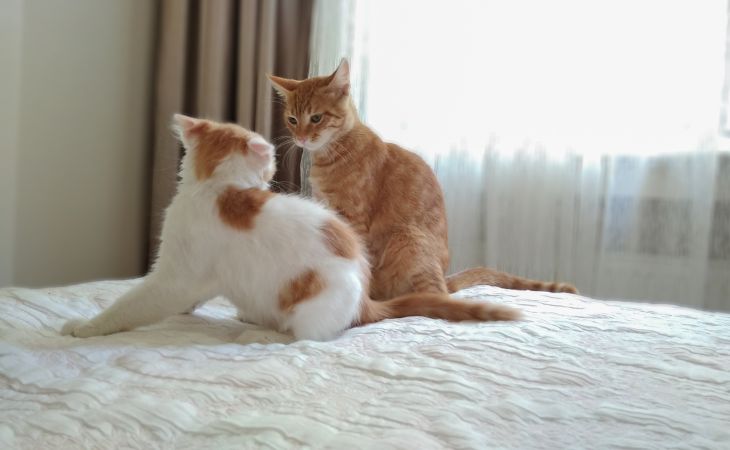Have you recently adopted a second cat and are already noticing tensions between the two of them? Unfortunately, cohabitation between cats is not always easy. This is especially the case between male and female cats. So, what are the causes of conflict between a male and female cat? What is the best way to react to manage conflict between cats? Is it possible to prevent this type of situation? Follow our guide to learn how to react.
Determine the sources of conflict between your male and female cat
Many reasons can explain why conflicts happen between male and female cats. For example, one common cause of conflict is related to heat cycles. If your cats are not spayed or neutered, there are small chances that the periods of reproduction of the two cats coincide. If your male is in heat while the female cat isn’t, she will not be ready to mate. The two of them will, therefore, be aggressive and this can leads to fights.
A cat can also be aggressive to protect their territory. Cats are very territorial animals and consider any and all visitors to be intruders. When you adopt a new cat, notably a female, the other cat feels in danger. They might be aggressive to protect their space and their toys. If the female has a very affirmed character and wants to mark her territory as well, the situation will be very tense between the two cats.
Your male could have a hard time accepting a new housemate because of their odor. Cats have a very developed sense of smell. They can distinguish certain odors perfectly well. One example of this is the smell of a vet clinic. If you adopt a female cat that just visited the vet clinic, she will be perceived as a danger for the other cat. Your first cat could become aggressive, complicating their relationship.
Have you taken in a sick or disabled cat? This situation can make them more aggressive than usual. When a cat suffers, they prefer to stay on their own and not be bothered. If the male is intrusive or wants affection, there will be high chances that the female will attack him.
This article might interest you as well: Male and female cats: what are the differences in everyday life?
What are the signs of a fight between cats?
Before we explain the signs of conflict between male and female cats, it’s important to explain the differences between a fight and a game. When two cats are having fun together, they chase after each other, nibble on each other, roll around on the ground, and meow loudly. If you notice this, there is nothing to worry about. As long as their is no aggressiveness between the two cats, everything is fine. You’ll notice if a game turns into a fight if the meows get louder.
This article might interest you: Understanding the difference between cats playing and fighting
The first sign of a conflict between a female and male cat is intimidation. Both of them will seek to impress the other at the beginning of the fight. By observing them well, you will notice their hair stand upright, their tails will be horizontal and they will hiss at each other. If nothing is done during this phase, one of the cats, notably the male, will advance slowly, in a lateral manner. The adversary will imitate their movements and start to be hostile.
When the fight starts, the cats will slap each other, trying to catch each other. In general, they will not use their claws. Both of them will seek to hurt the other and make the other cat submit thanks to their strength. They can finish in a roll-over. The one that has the upper hand will be seen as the cat in power because all of their paws are free. If one of the felines succeeds in slapping the back of the other, it means they won. The conflict is finished.

How do I manage conflict between my male and female cat?
If you do not succeed in preventing the fight before it happens, do not try to intervene. Your feline needs to go to the end of the combat for the fight to be finished between them. You are only pushing out the fight by separating them by force. They will fight again to determine who has won. In addition, if you intervene during the fight, you risk getting hurt. One of the cats can scratch you, for example, without trying to.
However, if you notice that the fight is affecting one cat more than the other and that they are getting badly hurt, you can intervene. Be alert and move the cats quickly away from each other to avoid getting attacked.
Prevent conflicts between your cats
Territoriality is one of the main reasons there are conflicts between male and female cats. Consequently; before adopting a female cat, prepare the space for your new pet. Your cats need to have very distinct territories.
When your female cat arrives, present them to each other. Ensure that each of them possesses enough space to climb, play, hide, and sleep. Also, be sure to prepare different bowls for your cats. You’ll need to buy a bowl for food and water and a new litter box. Some specialists even recommend providing a third litter box and scratching post.
It’s important to treat the two cats the same way. We recommend feeding and playing with them at the same moment. This will reinforce positive feelings with each other. If your male cat is gentle and affectionate with the female, but she becomes aggressive, it’s best to visit a vet. They might have caught an infection or are suffering from a painful wound. If your male cat is in heat and is very aggressive with the other, neutering is a possible solution. This procedure will reduce their aggressive tendencies and allow them to be more tolerant.
Get help from a feline behaviorist
A trained cat is more obedient and does less naughty things. With that being said, training a feline requires specific skills and experience. A feline behaviorist is your best ally if you want to train your felines friends. This specialist of human-pet relationships have a role to observe the behavior of cats to resolve problems. They intervene to ease the relationship between felines and their environment. It’s important to point out that they do not replace vets. Instead, they can work with these professionals to improve the well-being of the cat.
If you want a feline behaviorist to improve your cats’ relationship and help you prevent conflicts between your male and female cat, you need to choose the behaviorist well. Different types of criteria should be considered before deciding on one.
The level of education
Prioritize competent and trained professionals. To do this, research a behaviorist that attended several training courses and accompanied many cats. To make things easier for you, choose from behaviorists certified by the SFECA (French Society for the Study of Animal Behavior). These specialists are reliable and use practices approved by an animal industry committee.
Prioritize professionals who use positive methods. Punishment, example, is one training technique that should not be applied, even if your cats are aggressive. Avoid professionals that praise this method for calming conflicts between male and female cats.
The price of sessions
In France, for example, the price of an intervention from a feline behaviorist varies depending on the reason your need them and their reputation. The price of a behavioral assessment varies between 50 and 100 euros. To get rid of bothersome behavior, you need to spend around 100 to 250 euros. In order to not go over your budget, make sure you consult the references of feline behaviorists to choose one that proposes the best value for their service.

